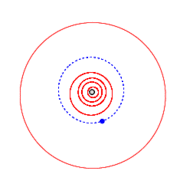9949 Brontosaurus
9949 Brontosaurus, provisional designation 1990 SK6, is a stony asteroid from the inner regions of the asteroid belt, roughly 10 kilometers in diameter. It was discovered on 22 September 1990, by Belgian astronomer Eric Elst at ESO's La Silla Observatory in northern Chile.[4] It was named after Brontosaurus, a genus of dinosaurs.[3]
 Orbit of Brontosaurus (blue), with the inner planets and Jupiter (outermost) | |
| Discovery [1] | |
|---|---|
| Discovered by | E. W. Elst |
| Discovery site | La Silla Obs. |
| Discovery date | 22 September 1990 |
| Designations | |
| (9949) Brontosaurus | |
| Pronunciation | /ˌbrɒntəˈsɔːrəs/[2] |
Named after | Brontosaurus (sauropod dinosaur)[3] |
| 1990 SK6 · 1978 GT1 1985 DM1 · 1992 BS | |
| main-belt [1][4] · (inner) | |
| Orbital characteristics [1] | |
| Epoch 4 September 2017 (JD 2458000.5) | |
| Uncertainty parameter 0 | |
| Observation arc | 38.98 yr (14,236 days) |
| Aphelion | 2.4982 AU |
| Perihelion | 2.2105 AU |
| 2.3544 AU | |
| Eccentricity | 0.0611 |
| 3.61 yr (1,319 days) | |
| 322.53° | |
| 0° 16m 22.08s / day | |
| Inclination | 7.7036° |
| 29.841° | |
| 174.63° | |
| Physical characteristics | |
| Dimensions | 4.231±0.086 km[5] 17 km[6] |
| 0.248±0.010[5] | |
| 13.8[1] | |
Orbit and classification
Brontosaurus orbits the Sun in the inner main-belt at a distance of 2.2–2.5 AU once every 3 years and 7 months (1,319 days). Its orbit has an eccentricity of 0.06 and an inclination of 8° with respect to the ecliptic.[1] It was first identified as 1978 GT1 at Crimea–Nauchnij in 1978, extending the body's observation arc by 12 years prior to its official discovery observation at La Silla.[4]
Physical characteristics
Diameter and albedo
According to the surveys carried out by the Infrared Astronomical Satellite IRAS and NASA's Wide-field Infrared Survey Explorer with its subsequent NEOWISE mission, Brontosaurus measures 17 and 4.231 kilometers in diameter, respectively.[5][6] WISE/NEOWISE also gives an albedo of 0.248 for the body's surface.[5] It has an absolute magnitude of 13.8.[1]
Rotation period
As of 2017, the asteroid's rotation period and shape remain unknown.[1][7]
Naming
This minor planet was named after Brontosaurus, a gigantic quadruped sauropod dinosaurs, which walked on all four legs and lived in the Upper Jurassic. Adult individuals measured up to 20 meters and had a weight of up to 20 tons. Many Fossils have been found in the United States. Brontosaurus is one of the best-known dinosaurs.[3] The official naming citation was published by the Minor Planet Center on 20 November 2002 (M.P.C. 47166).[8]
References
- "JPL Small-Body Database Browser: 9949 Brontosaurus (1990 SK6)" (2017-03-29 last obs.). Jet Propulsion Laboratory. Retrieved 22 June 2017.
- "Brontosaurus". Oxford English Dictionary (3rd ed.). Oxford University Press. September 2005. (Subscription or UK public library membership required.)
- Schmadel, Lutz D. (2007). "(9949) Brontosaurus". Dictionary of Minor Planet Names – (9949) Brontosaurus. Springer Berlin Heidelberg. p. 714. doi:10.1007/978-3-540-29925-7_7766. ISBN 978-3-540-00238-3.
- "9949 Brontosaurus (1990 SK6)". Minor Planet Center. Retrieved 17 March 2017.
- Masiero, Joseph R.; Mainzer, A. K.; Grav, T.; Bauer, J. M.; Cutri, R. M.; Dailey, J.; et al. (November 2011). "Main Belt Asteroids with WISE/NEOWISE. I. Preliminary Albedos and Diameters". The Astrophysical Journal. 741 (2): 20. arXiv:1109.4096. Bibcode:2011ApJ...741...68M. doi:10.1088/0004-637X/741/2/68. Retrieved 17 March 2017.
- Tedesco E.F.; Noah P.V.; Noah M.; Price S.D. "The supplemental IRAS minor planet survey (SIMPS)".
- "LCDB Data for (9949) Brontosaurus". Asteroid Lightcurve Database (LCDB). Retrieved 17 March 2017.
- "MPC/MPO/MPS Archive". Minor Planet Center. Retrieved 17 March 2017.
External links
- Asteroid Lightcurve Database (LCDB), query form (info)
- Dictionary of Minor Planet Names, Google books
- Asteroids and comets rotation curves, CdR – Observatoire de Genève, Raoul Behrend
- Discovery Circumstances: Numbered Minor Planets (5001)-(10000) – Minor Planet Center
- 9949 Brontosaurus at AstDyS-2, Asteroids—Dynamic Site
- 9949 Brontosaurus at the JPL Small-Body Database
